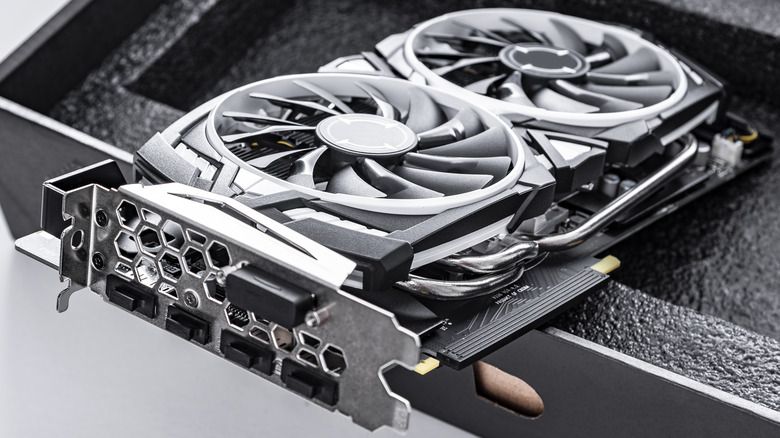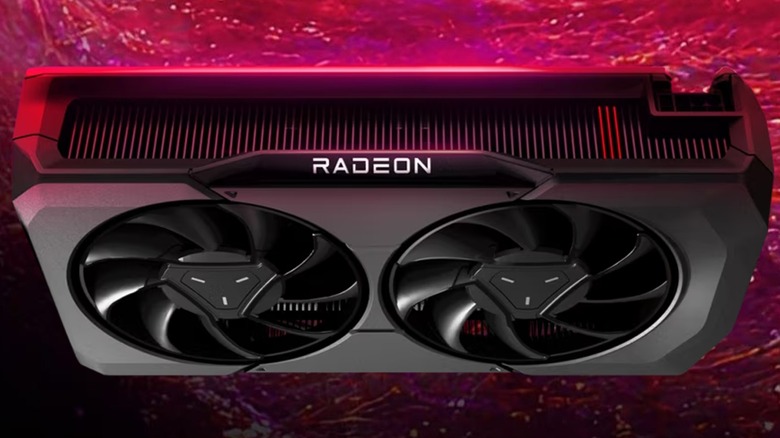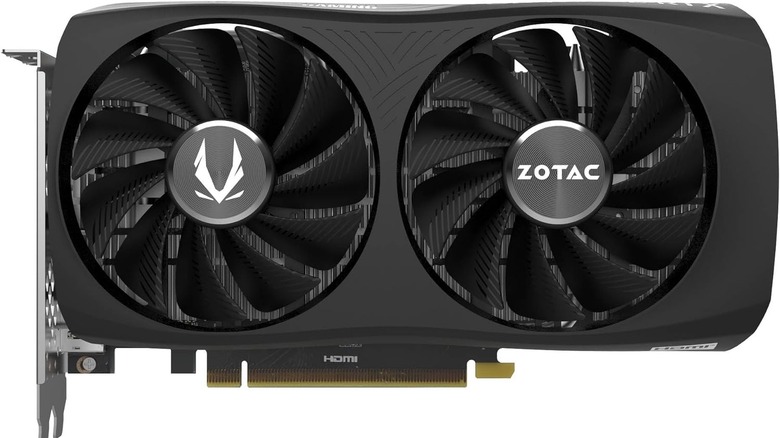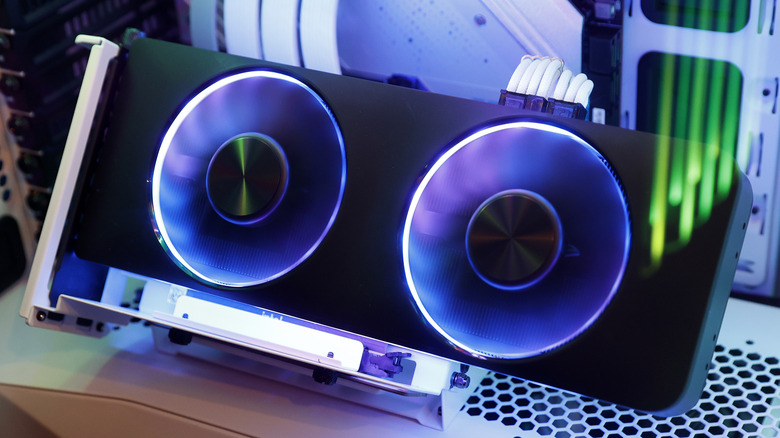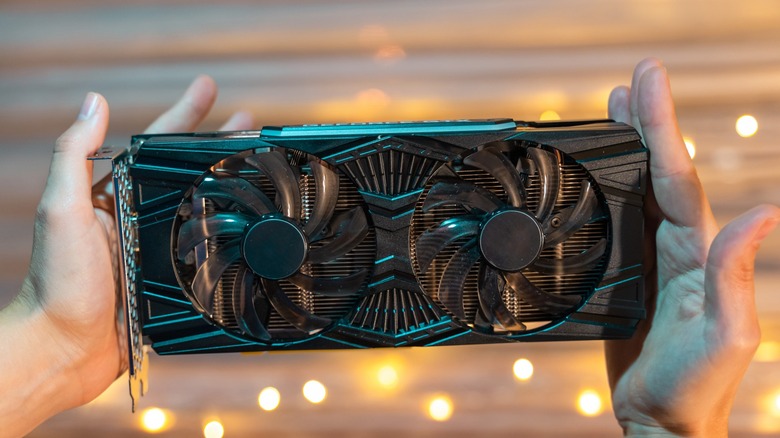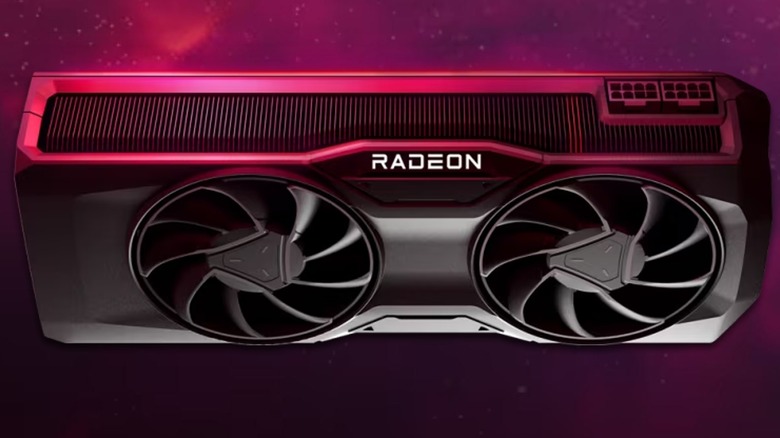5 Cheap Graphics Cards To Give Your Gaming PC The Boost It Needs
We may receive a commission on purchases made from links.
PC gaming without a graphics card is possible, but it's tough. You either need an integrated graphics solution, be it a built-in iGPU or an AMD APU, or you need a discrete GPU in your system. There are lots of options from AMD and Nvidia as well as a few from Intel. However, some of those cards can cost over $2,000, and that's enough money to build a high-end gaming PC on its own. Fortunately, not all of them are that pricey.
Although component manufacturers may sometimes have you believe otherwise, you don't need a top-of-the-line graphics card in order to play the latest games. As long as you're okay with compromising on graphics settings or resolution, you can get by with a really cheap GPU. The problem is finding one that's both cheap and decent, as the overlap between those two things is fairly limited.
In that case, what do you do when you're on a tight budget? Buy a discrete GPU that's affordable. We're here to show you some solid options that will let you play all your favorite games without breaking the bank.
AMD Radeon RX 7600
AMD's Radeon RX 7600 is one of the best graphics cards in terms of value right now. It's not the cheapest on our list, coming in at around $250 on Amazon, but it's a solid gateway to 1080p gaming, including AAA titles. However, it's not the only AMD option in this price range, which is good news for you.
The RX 7600 belongs to AMD's RDNA 3 GPU family. It comes with 32 compute units (CUs) and 2,048 shaders (GPU cores). More importantly, it features a fairly decent boost clock speed of 2,625 MHz and 8 GB of video memory (VRAM) across a 128-bit memory bus. These specs aren't enough to help it rival some of the top GPUs from either manufacturer, but they're enough to handle most games at decent frames, and that's even on ultra settings. Even resource-heavy titles like "Cyberpunk 2077" will play fine on the RX 7600, but only at 1080p. For 1440p, you'll need a better card.
The one downside of the RX 7600 is that it doesn't offer that much of a generational uplift from AMD's previous-gen offerings. There are GPUs at a similar price range that provide about the same performance, such as the $230 RX 6650 XT; there's also the RX 6600 XT and the (pricier) RX 6700 XT. If you can find any of these at a decent price, you can grab them instead of the RX 7600 without missing out on much.
Nvidia GeForce RTX 4060
Nvidia's RTX 4060 is the direct rival to AMD's RX 7600, but it has one major edge over its Team Red counterpart — it has access to Nvidia's Deep Learning Super Sampling (DLSS). That's not just any DLSS, by the way, it's the latest DLSS 3 and 3.5, which is Nvidia's proprietary upscaling technology that generates entire frames instead of just pixels, which is all the previous iterations could handle. This can result in a huge frame rate boost without sacrificing much visual quality.
This is important because a GPU that costs $300 on Amazon may not have a lot of juice on its own, but DLSS 3 can put the RTX 4060 in a different league entirely, making AAA games playable when they otherwise would have been a bit of a struggle. Mind you, it's not available in every game (far from it, actually), but the games that do support it will usually benefit from it. Of course, visual artifacts can happen when using upscaling tech.
In terms of specs, the GPU comes with a boost clock of 2,475 MHz, 8 GB of GDDR6 memory across a 128-bit bus, and 3,072 CUDA cores. The narrow bus and low memory can be a bit limiting, though, so if you don't care about DLSS 3, the RTX 3060 and the RTX 3060 Ti are both solid alternatives at a similar price range.
Intel Arc A750
For the first time in years, Intel is a viable option if you're in the market for a budget graphics card. In fact, that's the segment of the market where it truly gets to shine. Intel's Arc Alchemist lineup is its first serious venture into discrete graphics cards. The company is already well-known for making some of the best processors, but its GPU efforts are on a smaller scale. This means that Arc cards are solid budget picks but can't compete at the high end.
That's alright, though, because the Intel Arc costs just $217 on Amazon, which makes it a really cheap option for 1080p gaming. While Arc Alchemist had a bit of a tumultuous start and struggled with older games, things have evened out now after many driver updates. You should be able to play most games — except the most demanding titles — at 1080p.
The Arc A750 is overshadowed by its more powerful sibling, the Arc A770. While that GPU is priced at around $330, it's a better pick for performance reasons, especially the 16GB version. Still, at $330, you could also get an AMD RX 6700 XT.
Nvidia GeForce GTX 1660 Super
Nvidia's GTX 1660 Super is a pretty dated graphics card by now, but that doesn't make it bad. It's still a popular GPU according to Steam's Hardware Survey, and while it won't give you full ultra gameplay, you can usually get it on Amazon for around $160 from less-known manufacturers and in the ballpark of $200 if you prefer big brands like Asus. It'll also fit neatly in a budget-constrained build.
The downside of the GTX 1660 Super is that it has no access to Nvidia's DLSS or ray tracing. It's an older card from before the RTX era that's all the rage right now, and it shows. However, it remains popular for a reason — it can deliver decent 1080p gameplay across many titles, and it's a newer alternative to cards along the lines of the GTX 1060 6 GB.
In terms of specs, expect 6 GB of VRAM across a 192-bit memory bus and a boost clock of up to 1,530 MHz. If you'd like something more expensive, an Nvidia alternative is the RTX 3050 with somewhat similar performance and access to DLSS and ray tracing, but it costs $230. Of course, that's just a hair away from the $280 RTX 3060, which is vastly superior, but breaking the budget is a slippery slope, so tread carefully.
AMD Radeon RX 7800 XT
We're nearly out of the budget territory with the RX 7800 XT, but if you're building a PC for around $1,000 to $1,500, you can fit it in and enjoy a different level of gaming than what the other GPUs on this list can provide. Priced at roughly $520 on Amazon, the RX 7800 XT is a direct competitor to Nvidia's RTX 4070. While it doesn't provide access to DLSS 3, it does well enough with higher-end tasks like ray tracing, and it can also be used for comfortable 1440p gaming. That said, your mileage may vary depending on the title you're playing.
Specs-wise, we're getting 3,840 cores, 16 GB of GDDR6 memory with a 256-bit bus, and a boost clock of up to 2,520 MHz. This is a card that'll last you for years if you invest in it, and while it's not as impressive as some of its Nvidia counterparts, it's also cheaper. For instance, the RTX 4070 costs $600 and up. The downside of the RX 7800 XT is that it doesn't offer a massive generational leap over the RX 6800 XT, so if you can find that one cheaper, you're probably fine getting either one.
